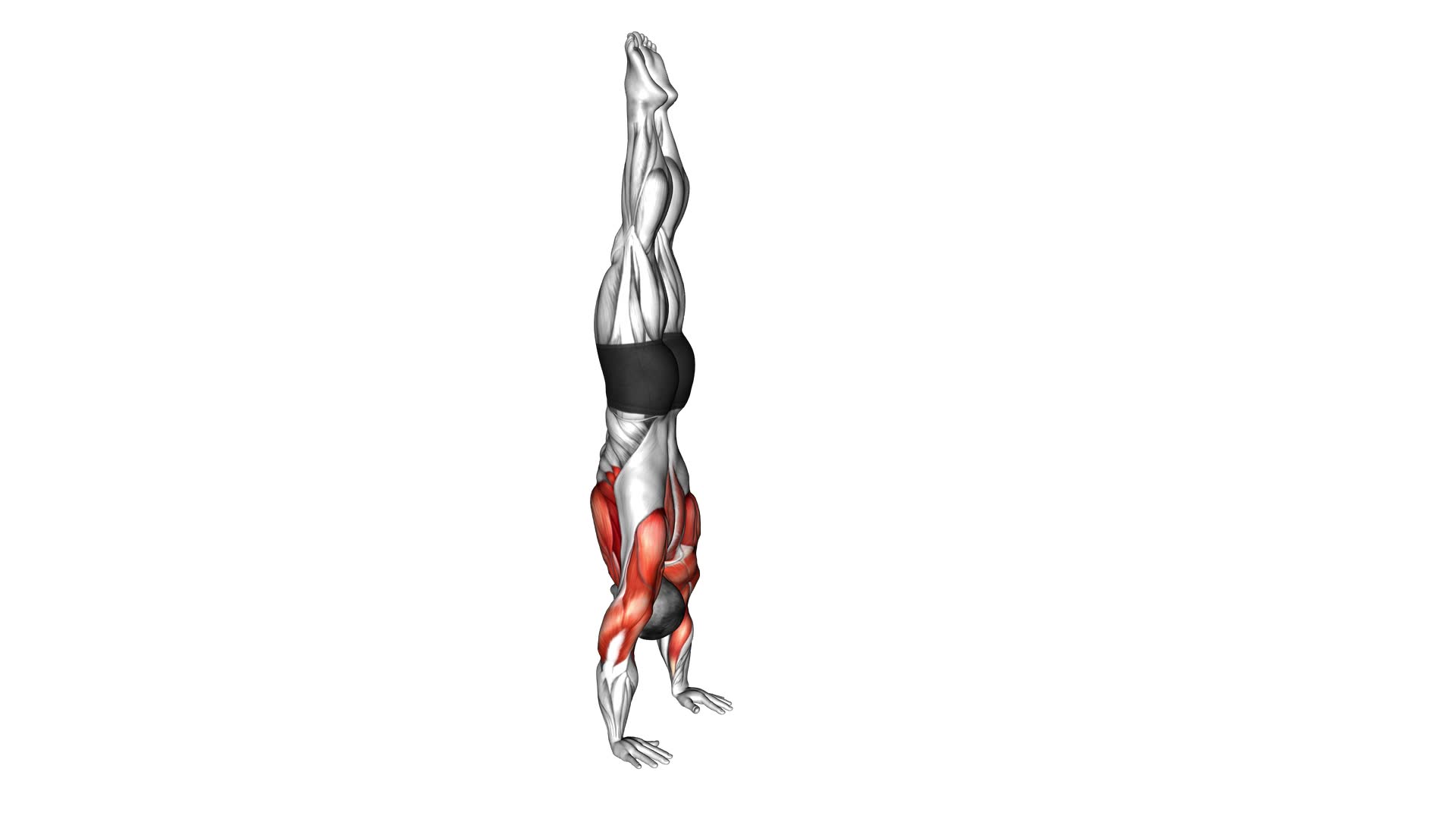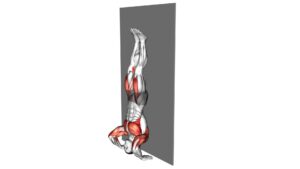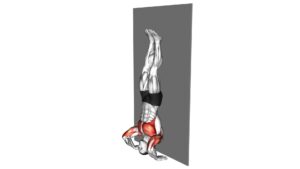Handstand Walk – Video Exercise Guide & Tips

Are you looking to improve your handstand walk?
Watch This Exercise Video
This video exercise guide and tips will help you master this challenging skill.
Learn the proper technique and avoid common mistakes as you build strength through progression exercises.
With expert advice and step-by-step instructions, you'll be on your way to confidently walking on your hands.
Get ready to take your fitness to new heights with the handstand walk!
Key Takeaways
- Handstand walking improves balance, shoulder strength, overall body strength, and stability.
- Proper technique includes practicing against a wall, focusing on body alignment and core engagement, starting with small steps, and trying different variations.
- Common mistakes to avoid are rushing the process, neglecting proper handstand balance and alignment, not engaging the core, and overlooking form and technique.
- Progression exercises to build strength include plank exercises, shoulder dislocate exercises, incorporating other core and upper body exercises, gradually increasing intensity, and consistent practice and progression.
Benefits of the Handstand Walk
Experience the many benefits of the handstand walk, a challenging exercise that targets your upper body and core muscles. The handstand walk isn't only a fun and impressive skill to master, but it also offers numerous advantages for your fitness journey.
One of the main benefits is improving balance. When you perform a handstand walk, you engage your core muscles to maintain stability and control. This constant balancing act helps to strengthen your core and improve your overall balance, which can be beneficial in various activities and sports.
Additionally, the handstand walk is an excellent exercise for increasing shoulder strength. As you walk on your hands, you're constantly supporting your body weight through your shoulders, forcing them to work hard and become stronger. This can lead to improved shoulder stability and mobility, reducing the risk of injuries and enhancing your performance in other upper body exercises.
Incorporating handstand walks into your workout routine can have a positive impact on your overall body strength and stability. By targeting your upper body and core muscles, this exercise helps you achieve a well-rounded and functional physique.
Proper Technique for Handstand Walking
Mastering the proper technique for handstand walking requires balance, control, and strength in your upper body and core muscles.
To begin, start by practicing your handstand against a wall. Kick up with both feet and focus on keeping your body straight and aligned. Engage your core and press through your hands to maintain balance.
Once you feel comfortable in your handstand, you can start working on the walking aspect. Begin by taking small steps with your hands, keeping your body straight and your core tight. As you gain confidence, you can start to increase the distance between each handstep.
To further challenge yourself, you can try different handstand walk variations such as walking in a straight line, walking in a circle, or even walking up and down stairs.
Incorporating handstand walk training drills into your routine, such as practicing on different surfaces or adding obstacles to navigate, can also help improve your overall balance and control.
By mastering the proper technique and incorporating variations and training drills, you'll be able to handstand walk with confidence and precision.
Now let's discuss common mistakes to avoid.
Common Mistakes to Avoid
One common mistake to avoid when attempting a handstand walk is rushing the process. It's important to take your time and focus on the proper technique to achieve a successful handstand walk.
One mistake people often make isn't maintaining proper handstand balance. To avoid this, make sure that your body is aligned in a straight line, with your shoulders stacked over your wrists and your hips directly above your shoulders. This will help you maintain stability and control as you walk on your hands.
Another common mistake is neglecting handstand alignment. It's crucial to keep your arms straight and your fingers spread wide to create a solid base of support. Additionally, engage your core muscles and squeeze your glutes to maintain a strong and stable position.
Progression Exercises to Build Strength
To build strength for the handstand walk, start by incorporating progression exercises into your routine. These exercises will help you develop the core stability and shoulder mobility required for a successful handstand walk.
One effective exercise to improve core stability is the plank. Begin by assuming a push-up position with your forearms on the ground. Make sure your body forms a straight line from your head to your heels. Hold this position for as long as you can, gradually increasing the duration over time. This exercise targets the muscles in your abdomen and lower back, which are essential for maintaining balance during a handstand walk.
In addition to core stability, shoulder mobility is crucial for executing a handstand walk. One exercise that can help improve shoulder mobility is the shoulder dislocate. Stand with your feet shoulder-width apart and hold a broomstick or resistance band with a wide grip. Slowly raise the stick or band over your head and behind your back, keeping your arms straight. Repeat this movement for several repetitions, gradually increasing the range of motion.
Tips for Mastering the Handstand Walk
To improve your chances of successfully mastering the handstand walk, it's important to focus on maintaining proper form and balance throughout the entire movement. One tip is to practice handstand walk variations to increase your overall strength and stability. These variations can include walking with your hands close together, walking with your hands wide apart, or even walking on your fingertips. By challenging yourself with different hand positions, you'll develop better control and coordination.
Another helpful tip is to incorporate handstand walk drills into your training routine. These drills can involve practicing against a wall, using a partner for support, or utilizing props such as blocks or parallettes. These drills will help you build the necessary strength and balance required for a successful handstand walk.
Additionally, it's crucial to focus on your core strength and stability. Engaging your core muscles while performing the handstand walk will help you maintain proper alignment and prevent any unnecessary wobbling or tipping over. Strengthening your core through exercises like planks, hollow holds, and Russian twists will greatly enhance your handstand walk ability.
Remember to start with proper hand placement, maintain a tight body position, and take small steps to maintain control. With consistent practice and attention to form, you'll be well on your way to mastering the handstand walk.
Frequently Asked Questions
How Long Does It Take to Master the Handstand Walk?
Mastering the handstand walk requires time and practice. It's not something you can achieve overnight. The length of time it takes to master this skill varies from person to person. Some individuals may pick it up quickly, while others may take longer.
It's important to note that handstand walking isn't suitable for beginners. It requires a certain level of strength, balance, and coordination. So, be patient with yourself and gradually work your way up to it.
Can Anyone Learn How to Handstand Walk, or Is It Only for Advanced Athletes?
Learning to handstand walk isn't just for advanced athletes; anyone can master this skill with practice and dedication. Whether you're a beginner or an experienced athlete, progress and technique are key.
Common mistakes include improper hand placement and lack of core strength. However, the benefits of handstand walking aren't limited to advanced athletes. It improves balance, coordination, and upper body strength, making it a valuable exercise for all fitness levels.
How Can I Prevent Wrist Pain While Practicing Handstand Walking?
To prevent wrist pain while practicing handstand walking, focus on injury prevention and improving wrist mobility. By incorporating exercises that strengthen the muscles and improve flexibility in your wrists, you can reduce the risk of discomfort or injury.
Take the time to warm up properly before each practice session and listen to your body. If you experience any pain or discomfort, it's important to rest and consult with a healthcare professional if necessary.
Are There Any Specific Warm-Up Exercises I Should Do Before Attempting the Handstand Walk?
Before attempting the handstand walk, it's important to do specific warm-up exercises to prepare your body. Incorporating dynamic stretches and focusing on shoulder mobility can help prevent injuries and improve performance.
These exercises will help loosen up your muscles and increase blood flow to the targeted areas. By taking the time to properly warm up, you'll be better prepared for the challenges of the handstand walk and reduce the risk of wrist pain or other discomfort.
What Are Some Alternative Exercises to the Handstand Walk That Can Still Help Improve Balance and Core Strength?
Looking for alternative exercises that improve balance and core strength?
Plank variations and yoga poses are great options. Planks engage your core muscles and challenge your balance. Try side planks, forearm planks, and plank jacks.
Yoga poses like tree pose, warrior III, and boat pose also enhance balance and strengthen your core.
These exercises are effective alternatives to the handstand walk and will help you achieve your fitness goals.
Conclusion
In conclusion, the handstand walk is a challenging exercise that offers numerous benefits, including improved core strength, balance, and shoulder stability.
By following proper technique and avoiding common mistakes, you can maximize the effectiveness of this exercise.
Additionally, incorporating progression exercises into your training routine can help build the necessary strength for mastering the handstand walk.
With dedication and practice, you can achieve success in this advanced movement.

Author
Years ago, the spark of my life’s passion ignited in my mind the moment I stepped into the local gym for the first time. The inaugural bead of perspiration, the initial endeavor, the very first surge of endorphins, and a sense of pride that washed over me post-workout marked the beginning of my deep-seated interest in strength sports, fitness, and sports nutrition. This very curiosity blossomed rapidly into a profound fascination, propelling me to earn a Master’s degree in Physical Education from the Academy of Physical Education in Krakow, followed by a Sports Manager diploma from the Jagiellonian University. My journey of growth led me to gain more specialized qualifications, such as being a certified personal trainer with a focus on sports dietetics, a lifeguard, and an instructor for wellness and corrective gymnastics. Theoretical knowledge paired seamlessly with practical experience, reinforcing my belief that the transformation of individuals under my guidance was also a reflection of my personal growth. This belief holds true even today. Each day, I strive to push the boundaries and explore new realms. These realms gently elevate me to greater heights. The unique combination of passion for my field and the continuous quest for growth fuels my drive to break new ground.







